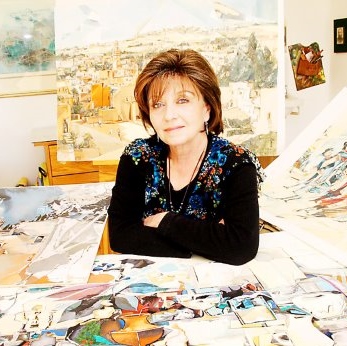click to dowload our latest edition
CLICK HERE TO SUBSCRIBE TO OUR NEWSLETTER


Published
7 years agoon
By
adminROBYN SASSEN
An institution in her own right, Nothmann effectively redefined the notion of religious Jewish art, in a world where the concept is dominated by a softened mediocre sense of cliché. Armed with her strong opinions and her instinctive understanding of what works, Nothmann effectively branded Jewish art with a delicate and fierce sense of luminescence and boldly made it her own.
Born in Jerusalem on February 12, 1943, Nothmann passed away in Johannesburg on September 9, from a pulmonary thrombosis, related to other medical conditions. She was 74.
A daughter of renowned Chassidic teacher and community activist Rabbi Eliyahu Kitov, Nothmann was always something of a maverick because of her great talent, which she followed as she held onto her Haredi roots.
But like an iconic fictional artist character, such as Chaim Potok’s Asher Lev, the young Nothmann was deeply supported by her father to grow into the best artist she could possibly be. Indeed, she was sent to begin studying art in Paris, during her formative years.
She later studied printmaking and painting in Israel and then relocated to the prestigious Delahanty School of Architecture in New York.
In 1981, she immigrated with her young family to South Africa, where she developed her skills and her exhibiting practice. Nothmann was endowed with a very sophisticated understanding of colour and texture and it lent to an approach to collage which was both innovative and outstanding in its sense of audacity and possibility.
Effectively, Nothmann’s use of collage was a blending of her architectural ethos with her fine art skills and she “painted” with the strips of coloured paper that comprised her work, which remains universally fresh.
Not only a collagist, Nothmann also chose to work in gouache and silkscreen and was deeply influenced by great 20th century modernists of the ilk of Pablo Picasso and Georges Braque, enjoying the way in which they smashed rubrics of art-making with Cubist thinking. Not an imitator but an innovator in her own capacity, Nothmann had a penchant for images that were shattered and put together again through the medium of frosted glass and mosaic. While in some respects, critics have over the years compared her work to the kind of ethos seen in the late work of Jewish modernist Marc Chagall, Nothman was always very much her own person and her enormous body of work, owned and shown the world over, bears testament to this.
Immensely prolific, Nothmann was deeply respected for her repertoire and was known to create enormous bodies of work for an exhibition in the space of just a few years. And while she successfully redefined the notion of religious art, her subject matter was not limited and ranged widely from the prosaic landscape and still life, the glorious image of children playing in the rain, to biblically evocative images. An artist who intimately understood the precepts and taboos of religious art, she also implicitly knew how far she could stretch her own skills. Far, very far.
Quickly becoming the darling, or the proverbial poster girl, for local Jewish institutions who wanted to develop and market beautiful products, from the time she began making South Africa her home, over the years Nothmann was often commissioned to illustrate greeting cards for Rosh Hashanah, opportunities which went a long way in making her work very central to a Jewish art ethos in South Africa.
Life for a full-time frum woman artist in South Africa was complicated by the need to earn a living and Nothmann was able to diversify a rich and full exhibiting programme with teaching adults the wonder and magic of artmaking. She proved to be a deeply beloved teacher to many.
With work housed in galleries as prestigious as the Guggenheim Museum in New York, Nothmann was well-known on the international gallery circuit. During the height of her career, she mounted over 40 solo exhibitions, not only in South Africa, but in Japan, Belgium, Hong Kong, Israel, England and the United States, to name but a few.
Nothmann had a great sense of savvy when it came to getting the image of her work into the public mindset, and while she was shown at galleries of the ilk of the Royal College of Art in London and Johannesburg’s Goodman Gallery, she didn’t consider herself above contributing work to communal drives and her pieces have often been shown through ORT, the Jewish Board of Deputies, the JNF and the like, for promotional reasons as much as fine art reasons.
Nothmann will be buried in Israel. She was divorced from her husband Moshe, and leaves three brothers and two sisters, three daughters and several grandchildren.
